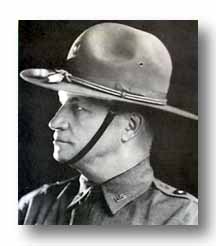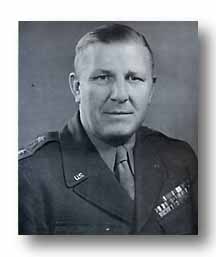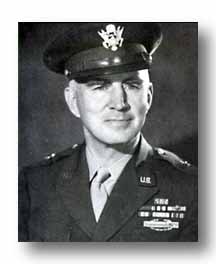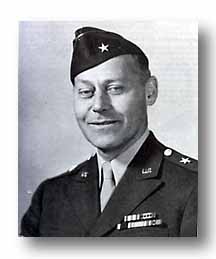DIVISION COMMANDERS
Granddaddy of the modern 36th Division, General Birkhead nurtured and watched over the Texas National Guard in the twenty-year interval between wars as Chief of Staff and, subsequently, Commanding General. He was CO of the old 131st Field Artillery with the AEF in World War I. Though a native of Oregon, where he was born in 1878, the General had been a staunch Texan since completing his schooling in Fort Worth. He entered prominently into Texas Law and politics for nearly half a century. General Birkhead led the 36th at the time of its activation into Federal Service, November, 1940, and retired from active duty in June 1942.
Soft-spoken, mild-mannered General Walker developed the 36th into a polished fighting team during its training days Stateside and in North Africa, then led it through the tough, heart-breaking Italian campaign from Salerno to Piombino. A graduate engineer from Ohio State University, General Walker was commissioned a lieutenant in the Regulars in 1911, marched with Pershing into Mexico, was wounded while serving with another crack outfit, the 3rd Division in World War I, where, as a battalion commander he won the Distinguished Service Cross in repelling a major German attack along the Marne. Forced to accept heavy losses with the 36th in the winter months at the Rapido and before Cassino, General Walker engineered the famed breakthrough move at Velletri and paced the Texans swiftly northward in the smashing drive above Rome. He later was assigned Commandant of the Infantry School at Fort Benning, Georgia, and became Director of Military Training, Army Service Forces. Afterwards, General Walker commanded the National Guard of Texas.
Energetic, unassuming General Dahlquist took charge of the 36th just before the Southern France invasion, spirited it through that highly successful venture and the spectacular drive that followed, and carried T-Patchers to final victory nine months later deep in the Austrian Tyrol. From Minneapolis and the University of Minnesota, as a young lieutenant he joined the Occupation Forces in Germany after World War I. Later he had a tour of duty in the Philippines and before the shadow of World War II appeared he became a qualified air observer. In July, 1942, General Dahlquist was appointed Deputy Chief of Staff to General Eisenhower in England. Tireless in battle, the General roved from point-to-point to spur on his front line units, once saw his aide, Captain Wells Lewis, killed beside him while leading the attack to relieve the "Lost Battalion" in the Vosges Forests. He determined the Division role which carried it over hitherto impregnable St. Marie Pass. Soon after V-J Day General Dahlquist was called to assignment with the Secretary of War's Personnel Board in Washington.
Long-time Assistant Division Commander
(February, 1944 - October, 1945) and frequent task force leader, big, white-haired
"Uncle Bob" was trained especially in tank tactics during his Army career and
commanded a Combat Command of the 1st Armored Division in the battle of Tunisia. On the
last day of the war he headed the mission that sought out and captured Hermann Goering
deep within the German line. General Stack succeeded General Dahlquist as Division
Commander in October, 1945, and brought the 36th home in December. He was from New York.
A West Pointer of the famous Class of 1915, General Hess was appointed Division Artillery Commander in November, 1943, in time to coordinate the big barrage on "Million Dollar Mountain." He served extensively with artillery units in World War I, commanding a battalion in the Argonne and Ypres - Lys Offensives. General Hess is proud of the artillery support his command was able to deliver to 36th Division infantry in World War II. A pet scheme of his was the "Bingo" -- calling down all available artillery on one target at one time. His home was in Pennsylvania.
One of the few general officers to hold the
Congressional Medal of Honor, General Wilbur won the award as a colonel in the North
African landings near Casablanca in November, 1942. Again, at Salerno, where he joined the
36th, General Wilbur coolly led a small unit forward to smash an enemy detachment during a
critical period in the bridgehead's defense. As Assistant Division Commander, he
frequently visited troops on rock ledges at Mignano Gap, gave the order that first halted
the slaughter on the Rapido.
As the Artillery Commander of the 36th Division
during the preparatory training phase in North Africa and the landing on the beaches of
Salerno on 9 September 1943, General Cowles exhibited outstanding ability as an
artilleryman. He was an instructor at the Artillery School at Ft. Sill, Oklahoma, for many
years prior to his assignment with the 36th Infantry Division.
General Lange joined the 36th as Assistant Division
Commander at Camp Blanding, Fla., in the spring of '42. He served in that capacity during
the final training days on the East Coast and in North Africa. A West Pointer also,
General Lange fought at Verdun and Toul in World War I, was awarded the French Croix de
Guerre. He had several teaching assignments between the wars, became Professor of Military
Science at the University of Florida.
|

 MAJOR GENERAL CLAUDE V. BIRKHEAD
MAJOR GENERAL CLAUDE V. BIRKHEAD MAJOR
GENERAL FRED L. WALKER
MAJOR
GENERAL FRED L. WALKER MAJOR
GENERAL JOHN E. DAHLQUIST
MAJOR
GENERAL JOHN E. DAHLQUIST BRIGADIER
GENERAL ROBERT I. STACK
BRIGADIER
GENERAL ROBERT I. STACK BRIGADIER
GENERAL WALTER W. HESS
BRIGADIER
GENERAL WALTER W. HESS BRIGADIER
GENERAL WILLIAM H. WILBUR
BRIGADIER
GENERAL WILLIAM H. WILBUR BRIGADIER
GENERAL MILES A. COWLES
BRIGADIER
GENERAL MILES A. COWLES BRIGADIER
GENERAL OTTO F. LANGE
BRIGADIER
GENERAL OTTO F. LANGE